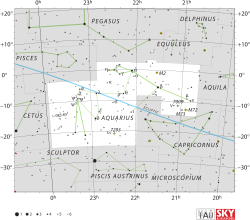Eta Aquarii
| Observation data Epoch J2000 Equinox J2000 |
|
|---|---|
| Constellation | Aquarius |
| Right ascension | 22h 35m 21.38126s |
| Declination | –00° 07′ 02.9888″ |
| Apparent magnitude (V) | 4.04 |
| Characteristics | |
| Spectral type | B9IV-Vn |
| U−B color index | –0.28 |
| B−V color index | –0.10 |
| Astrometry | |
| Radial velocity (Rv) | –8.0 km/s |
| Proper motion (μ) |
RA: +89.74 mas/yr Dec.: –56.10 mas/yr |
| Parallax (π) | 19.43 ± 0.25mas |
| Distance | 168 ± 2 ly (51.5 ± 0.7 pc) |
| Details | |
| Radius | 2.9 R☉ |
| Temperature | 11,219 ± 82 K |
| Rotational velocity (v sin i) | 291 km/s |
| Other designations | |
| Database references | |
| SIMBAD | data |
Eta Aquarii (η Aqr, η Aquarii) is the Bayer designation for a star in the equatorial constellation of Aquarius. It is visible to the naked eye with an apparent visual magnitude of 4.04. The distance to this star, as determined by parallax measurements, is about 168 light-years (52 parsecs). Eta Aquarii is near the radiant of a meteor shower named after it.
Eta Aquarii has a stellar classification of B9IV-Vn, which may indicate that it is beginning to evolve away from the main sequence into a subgiant as the supply of hydrogen at its core becomes exhausted. It is spinning rapidly with a high projected rotational velocity of 291 km/s. This is causing an equatorial bulge, giving the star an oblate figure with a 24% larger radius at the equator than at the poles. The Doppler effect from the rapid rotation is causing the absorption lines in the star's spectrum to blur, as indicated by the 'n' suffix in the star's classification.
This star is sometimes called Hydria, from the Greek word ‘υδρια (hudria), meaning "water jar". Another name of this star is Deli, derived from Hebrew word דלי (dali), literally meaning "hard".
This star, along with γ Aqr (Sadachbia), π Aqr (Seat) and ζ Aqr (Sadaltager / Achr al Achbiya), were al Aḣbiyah (الأخبية), the Tent.
...
Wikipedia

